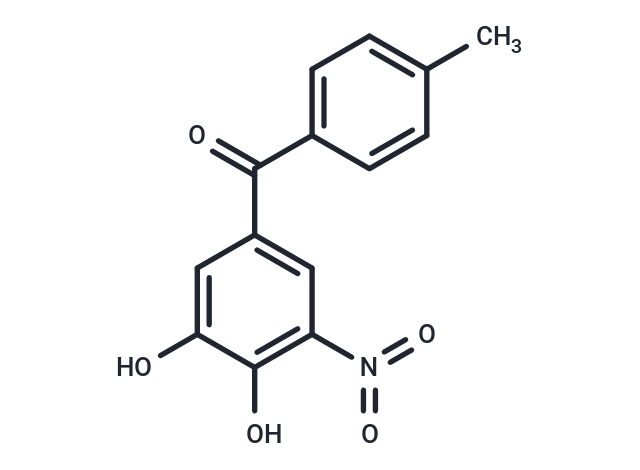Shopping Cart
- Remove All
 Your shopping cart is currently empty
Your shopping cart is currently empty

Tolcapone (Ro 40-7592) is a catechol-O-methyltransferase inhibitor employed as an adjunctive therapy with levodopa and carbidopa in the treatment of Parkinson's disease.

| Pack Size | Price | Availability | Quantity |
|---|---|---|---|
| 5 mg | $32 | In Stock | |
| 10 mg | $45 | In Stock | |
| 25 mg | $79 | In Stock | |
| 50 mg | $98 | In Stock | |
| 100 mg | $133 | In Stock | |
| 200 mg | $189 | In Stock | |
| 500 mg | $316 | In Stock | |
| 1 mL x 10 mM (in DMSO) | $50 | In Stock |
| Description | Tolcapone (Ro 40-7592) is a catechol-O-methyltransferase inhibitor employed as an adjunctive therapy with levodopa and carbidopa in the treatment of Parkinson's disease. |
| Targets&IC50 | COMT:30 nM(Ki) |
| In vitro | Tolcapone functions as a selective peripheral and central COMT inhibitor, exerting no effect on adrenergic, serotonergic, or cholinergic receptors or other enzymes involved in synthesis or catabolism of catecholamines. [1] Tolcapone produces a concentration-dependent decrease in COMT activity in liver homogenates of developing (3 days-old) and adult (60 days-old) rats with Vmax, Km and IC50 of 5.3 nM/mg/h, 3.3 μM, 41 nM, and 2.9 nM/mg/h, 13.1 μM, 720 nM, respectively. Tolcapone produces a concentration-dependent decrease in COMT activity in kidney of developing (3 days-old) and adult (60 days-old) rats with Vmax, Km and IC50 of 2.6 nM/mg/h, 2.7 μM, 8 nM, and 3.5 nM/mg/h, 24 μM, 177 nM, respectively. [2] |
| In vivo | Tolcapone orally administrated is able to crosses the blood-brain barrier. Acute administration of Tolcapone increases basal levels of L-DOPA and dihydroxyphenylacetic acid (DOPAC) and decreases basal homovanillic acid (HVA) levels, but does not affect basal dopamine levels. [3] Tolcapone (30 mg/kg p.o.) combined with benserazide (15 mg/kg p.o.) and a low dose of L-dopa (10 mg/kg p.o.) almost completely blockes (for about 6 h) the formation of 3-O-methyldopa (3-OMD) in brain and plasma, producing a long-lasting increase of L-DOPA in plasma and a parallel marked increase of L-DOPA and dopamine in the brain. [4] Tolcapone displays behavioural and neurochemical benefits on animals. Tolcapone (30 mg/kg p.o.) increases the effect of L-DOPA (plus benserazide) on locomotor activity, reserpine-induced hypothermia, and catalepsy induced by pimozide, haloperidol and fluphenazine. Tolcapone also increases locomotor hyperactivity induced by amphetamine or nomifensine, as well as stereotypy induced by amphetamine (but not apomorphine). [5] |
| Kinase Assay | Enzyme assay and binding assay: Protein kinase C is assayed in a reaction mixture (0.25 mL) containing 5 μmol of Tris/HCl, pH 7.5, 2.5 μmol of magnesium acetate, 50 μg of histone II S, 20 μg of phosphatidylserine, 0.88 μg of diolein, 125 nmol of CaCl2, 1.25 nmol of [γ-32]ATP (5-10 × 104 cpm/nmol) and 5 μg of partially purified enzyme. The binding of [3H]PDBu to protein kinase C is determined: Reaction mixture (200 μL contained 4 μmo1 of Tris/malate, pH 6.8, 20 μmol of KCl, 30 nmol of CaC12, 20 μg of phosphatidylserine, 5 μg of partially purified protein kinase C, 0.5% (final concentration) of DMSO,10 pmol of [3H]PDBu (l-3 × 104 cpm/pmol) and 10 μL of various amounts of Staurosporine. |
| Alias | Tasmar, Ro 40-7592 |
| Molecular Weight | 273.24 |
| Formula | C14H11NO5 |
| Cas No. | 134308-13-7 |
| Smiles | C(=O)(C1=CC(N(=O)=O)=C(O)C(O)=C1)C2=CC=C(C)C=C2 |
| Relative Density. | 1.419g/cm3 |
| Storage | Powder: -20°C for 3 years | In solvent: -80°C for 1 year | Shipping with blue ice. | ||||||||||||||||||||||||||||||||||||||||
| Solubility Information | Ethanol: 27.3 mg/mL (99.91 mM), Sonication is recommended. DMSO: 40 mg/mL (146.39 mM), Sonication is recommended. | ||||||||||||||||||||||||||||||||||||||||
Solution Preparation Table | |||||||||||||||||||||||||||||||||||||||||
Ethanol/DMSO
DMSO
| |||||||||||||||||||||||||||||||||||||||||

Copyright © 2015-2025 TargetMol Chemicals Inc. All Rights Reserved.